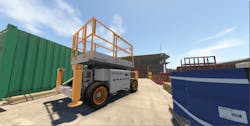Virtual Reality Targets Safety for the Aerial Lift Industry
If you spend any significant time in manufacturers’ booths at trade shows, you’ve probably noted the growing number of virtual reality (VR) technology demonstrations.
VR simulation is poised to change training as we know it, and seemingly everyone is on board. Three high-def screens arranged around a vibrating chair with joysticks attached simply won’t be enough as VR becomes increasingly affordable and more realistic. And we already know that simulation is safer—and more fuel efficient—than on-the-job learning. Machines won't return to the yard dented, either.
One of the more complete efforts so far comes from the lift and access industry. Not only is it responding to new and more stringent safety standards, but it's also recognizing a workforce trend.
“The labor force is changing,” says Jim Colvin, CEO, of Canada’s Serious Labs, makers of a new Aerial Virtual Reality Training Simulator. “Millennials are entering the workforce and they prefer to learn in a different way. Immersive VR simulations provide the perfect learning medium where these new operators can explore realistic jobsite environments and safely test the limits of equipment in dangerous situations. Simulators were previously only available in industries such as aviation, but they are ideal for the construction industry where safety and competency are paramount.”
The simulator combines Serious Labs’ scissor lift modules with its boom lift modules to provide a comprehensive aerial operator training solution for the rental industry, which recognizes that it is often dealing with less experienced operators.
The new scissor lift modules consist of 18 training scenarios on slab and diesel rough-terrain scissor lifts. There are also 16 articulating boom lift scenarios. The simulations progressively become more challenging, isolating tasks around driving, lifting, platform positioning, and operating. Each module will take the novice approximately one hour and fifteen minutes to complete; a seasoned professional about 45 minutes. Metrics provide feedback about the operator’s performance, showing weakness and strengths.
The scissor lift scenarios were co-developed by Nationwide Platforms in the U.K., a division of Loxam Group, an equipment rental company. Operations Director Peter Douglas, a safety expert and aerial industry veteran of 28 years, spent almost a year test marketing Serious Labs’ simulator with Nationwide Platform customers in the United Kingdom. His feedback helped Serious Labs’ designers ensure critical operating training skills were captured.
“People get very excited about VR,” says Douglas. “And then when they jump on it, it’s so real. You feel everything: driving, steering, and moving. It’s incredible. We are really excited we can use this technology to improve safety and training. It’s at the heart of everything we do.”
The simulator kit includes Serious Labs’ motion base, connecting what the operator sees with sensory feedback. “Because the motion base makes you feel just like you are moving on an aerial, the operator can become fully emerged in the virtual world of a jobsite,” says Wade Carson, director of business development for Serious Labs. “This feeling is what provides the critical capability of suspended disbelief allowing the user to become engaged in the training. It also eliminates the nausea which is felt in some VR products that are on the market today.”
Skyjack, a scissor lift manufacturer, provided guidance on the development of the scenarios, including key feedback on the representative scissor lift models, sensory feeling, and realism. “One of the real benefits of VR training is the ability to safely put the operator in risky situations so that they can develop the necessary skills, without the risk of physical harm. This gives the trainee proper respect for the equipment,” says Ian McGregor, director of product safety at Skyjack.
“You can look down and have the sensation of being at height, you load the equipment on a truck and you feel the bumps, etc. Overall, this is a great way to improve an operator’s skills while they are on the pathway to become a qualified operator,” McGregor says.
The simulator requires an Internet connection and functions on a cloud-based delivery system and operates on a basic 15-amp outlet. The simulator kit includes a converter for international countries. The physical footprint is 2ft 8in x 2ft 8in, with full setup measuring 4’ x 8’. The kit includes a VR headset, a safety cage, scissor lift controls, and oculus touch controls that automatically calibrate the headset for each operator.
The simulator allows the operator to meet IPAF and ANSI training requirements in a dynamic environment, outside of the actual equipment. The training scenarios map 1:1 on assessment for certification validation while tracking the movement of best practices.
“Safety training needs to be a collaborative effort for it to be the absolute best it can be,” says Colvin. “The aerial equipment industry is truly unified by one common goal: to get people home from work safely.”
